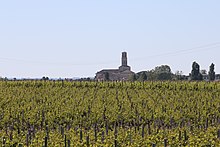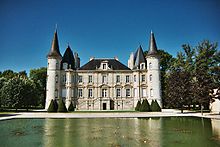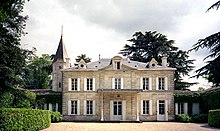


Bordeaux wine (Occitan: vin de Bordèu, French: vin de Bordeaux) is produced in the Bordeaux region of southwest France, around the city of Bordeaux, on the Garonne River. To the north of the city, the Dordogne River joins the Garonne forming the broad estuary called the Gironde; the Gironde department, with a total vineyard area of 110,800 hectares,[1] is the second largest wine-growing area in France behind the Languedoc-Rousillon .[2]
Average vintages produce over 700 million bottles of wine, ranging from large quantities of daily table wine to some of the world's most expensive and prestigious wines. The vast majority of wine produced in Bordeaux is red (sometimes called "claret" in Britain), with sweet white wines (most notably Sauternes), dry whites, and (in much smaller quantities) rosé and sparkling wines (Crémant de Bordeaux) collectively making up the remainder. Bordeaux wine is made by more than 5,660 producers or châteaux. There are 65 appellations of Bordeaux wine.[3][4]

Viticulture was introduced into the Bordeaux region by the Romans, probably in the mid-1st century CE,[5] to provide wine for local consumption, and wine production has been continuous in the region since then.[6][failed verification]
During the 12th century, the popularity of Bordeaux wines in England increased dramatically following the marriage in 1152 of Henry Plantagenet and Eleanor of Aquitaine,[7] whose Aquitaine lands included the Bordeaux region. Henry Plantagenet became King Henry II of England in 1154, and within his so-called Angevin Empire Bordeaux developed a long-lived export market for its wine in England.[8][better source needed][9] At this time, Graves was the principal wine region of Bordeaux, and the principal style was clairet. This accounts for the ubiquity of claret in England, though the anglicized term "claret" came to be used by English-speakers for a period to refer to all red wine rather than to the claret style specifically.[10] The export of Bordeaux was interrupted by the Hundred Years' War outbreak between France and England in 1337.[7] By the end of the conflict in 1453 France had repossessed the province, thus taking control of wine production in the region.[7] As part of the Auld Alliance, the French granted Scottish merchants a privileged position in the trade of claret. This position continued largely unchanged after the Treaty of Edinburgh ended the military alliance between France and Scotland.[11] Even when the by then Protestant kingdoms of England and Scotland, both ruled by the same Stuart king by this point, were trying to militarily aid the Huguenot rebels in their fight against Catholic France in La Rochelle, Scots trading vessels were not only permitted to enter the Gironde, but the French navy escorted them safely to the port of Bordeaux to protect them from Huguenot privateers.
In the seventeenth century, Dutch traders drained the swampy ground of the Médoc so it could be planted with vines, and this gradually surpassed Graves as the most prestigious region of Bordeaux. Malbec was the dominant grape here, until the early 19th century, when it was replaced by Cabernet Sauvignon.[6]
In 1855, the châteaux of Bordeaux were classified; this classification remains widely used today. From 1875 to 1892 almost all Bordeaux vineyards were ruined by phylloxera infestations.[7] The region's wine industry was rescued by grafting native vines onto pest-resistant American rootstock.[7]


The major reason for the success of winemaking in the Bordeaux region is the excellent environment for growing vines. The geological foundation of the region is limestone, leading to a soil structure that is heavy in calcium. The Gironde estuary dominates the regions along with its tributaries, the Garonne and the Dordogne rivers, and together irrigate the land and provide an Atlantic Climate, also known as an oceanic climate, for the region.[12] Bordeaux lies at the center of the confluence of the Dordogne and Garonne Rivers, which flow into the Gironde.[13]
These rivers define the main geographical subdivisions of the region:
In Bordeaux the concept of terroir plays a pivotal role in wine production with the top estates aiming to make terroir driven wines that reflect the place they are from, often from grapes collected from a single vineyard.[12] The soil of Bordeaux is composed of gravel, sandy stone, and clay. The region's best vineyards are located on the well-drained gravel soils that are frequently found near the Gironde river. An old adage in Bordeaux is the best estates can "see the river" from their vineyards. The majority of land facing riverward is occupied by classified estates.[12]

Red Bordeaux is generally made from a blend of grapes. Permitted grapes are Cabernet Sauvignon, Cabernet Franc, Merlot, Petit Verdot, Malbec and Carménère.[14] Today Carménère is rarely used, with Château Clerc Milon, a fifth growth Bordeaux, being one of the few to still retain Carménère vines. As of July 2019, Bordeaux wineries authorized the use of four new red grapes to combat effects of climate change on viticulture in Bordeaux, though only for those wines designated as Bordeaux or Bordeaux Supérior. These newly approved grapes are Marselan, Touriga Nacional, Castets, and Arinarnoa.[15][16]
As a broad generalisation, Cabernet Sauvignon (Bordeaux's second-most planted grape variety) dominates the blend in red wines produced in the Médoc and the rest of the left bank of the Gironde estuary. Typical top-quality Châteaux blends are 70% Cabernet Sauvignon, 15% Cabernet Franc and 15% Merlot. This is typically referred to as the "Bordeaux blend". Merlot tends to predominate in Saint-Émilion, Pomerol and the other right bank appellations. These Right Bank blends from top -quality Châteaux are typically 70% Merlot, 15% Cabernet Franc and 15% Cabernet Sauvignon.[17]

White Bordeaux is predominantly, and exclusively in the case of the sweet Sauternes, made from Sémillon, Sauvignon blanc and Muscadelle. Typical blends are 80% Sémillon and 20% Sauvignon blanc. As with the reds, white Bordeaux wines are usually blends, most commonly of Sémillon and a smaller proportion of Sauvignon blanc. Other permitted grape varieties are Sauvignon gris, Ugni blanc, Colombard, Merlot blanc, Ondenc and Mauzac. Recently permitted by Bordeaux wineries, three new white grapes have been added. These grapes are Alvarinho, Petit Manseng, and Liliorila.[15]
In the late 1960s Sémillon was the most planted grape in Bordeaux. Since then it has been in constant decline although it still is the most common of Bordeaux's white grapes. Sauvignon blanc's popularity on the other hand has been rising, overtaking Ugni blanc as the second most planted white Bordeaux grape in the late 1980s and now being grown in an area more than half the size of that of the lower yielding Sémillon.
Wineries all over the world aspire to making wines in a Bordeaux style. In 1988, a group of American vintners formed The Meritage Association to identify wines made in this way. Although most Meritage wines come from California, there are members of the Meritage Association in 18 states and five other countries, including Argentina, Australia, Canada, Israel, and Mexico.

The red grapes in the Bordeaux vineyard are Merlot (62% by area), Cabernet Sauvignon (25%), Cabernet Franc (12%) and a small amount of Petit Verdot, Malbec and Carménère (1% in total). The white grapes are Sémillon (54% by area), Sauvignon blanc (36%), Muscadelle (7%) and a small amount of Ugni blanc, Colombard and Folle blanche (3% in total).[3] Because of the generally humid Bordeaux climate, a variety of pests can cause a problem for the vigneron. In the past, this was counteracted by the widespread use of pesticides, although the use of natural methods has recently been gaining in popularity. The vines are generally trained in either single or double guyot. Hand-picking is preferred by most of the prestigious châteaux, but machine-harvesting is popular in other places.[14]
Following harvest, the grapes are usually sorted and destemmed before crushing. Crushing was traditionally done by foot, but mechanical crushing is now almost universally used. Chaptalization is permitted, and is fairly common-place. Fermentation then takes place, usually in temperature controlled stainless steel vats. Next the mustispressed and transferred to barriques (in most cases) for a period of ageing (commonly a year). The traditional Bordeaux barrique is a 225-litre oak barrel. At some point between pressing and bottling the wine is blended. This is an integral part of the Bordeaux wine making process, as scarcely any Bordeaux wines are varietals; wine from different grape varieties is mixed together, depending on the vintage conditions, so as to produce a wine in the château's preferred style. In addition to mixing wine from different grape varieties, wine from different parts of the vineyard is often aged separately, and then blended into either the main or the second wine (or sold off wholesale) according to the judgment of the winemaker. The wine is then bottled and usually undergoes a further period of ageing before it is released for sale.[14]




The Bordeaux wine region is divided into subregions including Saint-Émilion, Pomerol, Médoc, and Graves. The 60 Bordeaux appellations and the wine styles they represent are usually categorized into six main families, four red based on the subregions and two white based on sweetness:[18]
The vast majority of Bordeaux wine is red, with red wine production outnumbering white wine production six to one.[6]
There are four different classifications of Bordeaux, covering different parts of the region:[25]
The 1855 classification system was made at the request of Emperor Napoleon III for the Exposition Universelle de Paris. This came to be known as the Bordeaux Wine Official Classification of 1855, which ranked the wines into five categories according to price. The first growth red wines (four from Médoc and one, Château Haut-Brion, from Graves), are among the most expensive wines in the world.

The first growths are:
At the same time, the sweet white wines of Sauternes and Barsac were classified into three categories, with only Château d'Yquem being classified as a superior first growth.
In 1955, St. Émilion AOC were classified into three categories, the highest being Premier Grand Cru Classé A with two members:[25]
In the 2012 classification, two more Châteaux became members:
There is no official classification applied to Pomerol. However some Pomerol wines, notably Château Pétrus and Château Le Pin, are often considered as being equivalent to the first growths of the 1855 classification, and often sell for even higher prices.

Bordeaux wine labels generally include:[28]

Claret (/ˈklærɪt/ KLARR-it) is a name primarily used in British English for red Bordeaux wine. Claret derives from the French clairet, now a rare dark rosé, which was the most common wine exported from Bordeaux until the 18th century.[29] The name was anglicised to "claret" as a result of its widespread consumption in England during the period in the 12th–15th centuries that Aquitaine was part of the Angevin Empire and continued to be controlled by Kings of England for some time after the Angevins. It is a protected name within the European Union, describing a red Bordeaux wine, accepted after the British wine trade demonstrated over 300 years' usage of the term.[29]

Claret is occasionally used in the United States as a semi-generic label for red wine in the style of the Bordeaux, ideally from the same grapes as are permitted in Bordeaux. The French themselves do not use the term, except for export purposes. The meaning of "claret" has changed and now refers to a dry, dark-red Bordeaux.[29] It has remained a term associated with the English upper class and consequently appears on bottles of generic red Bordeaux to raise their status in the market. In November 2011 the president of the Union des Maisons de Négoce de Bordeaux announced an intention to use the term claret de Bordeaux for wines that are "light and fruity, easy to drink, in the same style as the original claret when it was prized by the English in former centuries".[30] "Claret" is also sometimes used as a colour name to refer to the dark, purplish-red colour of Bordeaux wine. In Britain and Australia, "claret" has also been a slang term for blood.[31]


Many of the top Bordeaux wines are primarily sold by receiving the related payment in advance, the so-called selling en primeur. Because of the combination of longevity, fairly large production, and an established reputation, Bordeaux wines tend to be the most common wines at wine auctions.
Market reports released in February 2009 showed that the market had increased in buying power by 128% while the prices had been lowered for the very best Bordeaux wines.[32]
Syndicate des Vins de Bordeaux et Bordeaux Supérieur is an organization representing the economic interests of 6,700 wine producers in Bordeaux, France. The wine lake and other economic problems have increased the salience of the winemakers' association, whose members are facing increasing costs and decreasing demand for their product.
As the largest appellation producing fine wines, and the strong foundation of the pyramid of Bordeaux wines, Bordeaux AOC & Bordeaux Supérieur AOC today account for 55% of all Bordeaux wines consumed in the world.
Plan Bordeaux was an initiative introduced in 2005 by ONIVINS, the French vintners association, designed to reduce France's wine production in order to improve profitability for the remaining producers. Part of the plan was to uproot 17,000 hectares of the 124,000 hectares of vineyards in Bordeaux.[33] The wine industry in Bordeaux has been experiencing economic problems in the face of strong international competition from New World wines and declining wine consumption in France.[34]
In 2004, exports to the U.S. plummeted 59% in value over the previous year. Sales in Britain dropped 33% in value during the same period. The UK, a major market, now imports more wine from Australia than from France. Amongst the possible causes for this economic crisis are that many consumers tend to prefer wine labels that state the variety of grape used, and often find the required French AOC labels difficult to understand.[citation needed]
Christian Delpeuch, president emeritus of Plan Bordeaux hoped to reduce production, improve quality, and sell more wine in the United States. However, two years after the beginning of the program, Mr Delpeuch[35] resigned, "citing the failure of the French government to address properly the wine crisis in Bordeaux." Delpeuch told journalists assembled at the Bordeaux Press Club "I refuse to countenance this continual putting off of decisions which can only end in failure."[35] "Delpeuch said he was shocked and disappointed by the failure of his efforts—and by the lack of co-operation from winemakers and négociants themselves—to achieve anything concrete in terms of reforms to the Bordeaux wine industry over the last 24 months."[35] The future of Plan Bordeaux is uncertain.
[...] The Romans first intensively sponsored viticulture in Gaul in their province of Narbonensis, and it is unlikely to have extended beyond this Mediterranean-Rhône region until the first-century CE. [...] Vines were first recorded in Bordeaux in the first century CE.
Bordeaux established a monopoly in the production, sale and distribution of wine to Great Britain.
[...] In the 13th century, Bordeaux became the main port for exporting wine to England, and its position has never faltered in the subsequent 800 years [...].
A name originally given (like French vin clairet) to wines of yellowish or light red color, as distinguished alike from 'red wine' and 'white wine'; the contrast with the former ceased about 1600, and it was then used for red wines generally [...]. Now applied to the red wines imported from Bordeaux, generally mixed with Benicarlo or some full-bodied French wine.(Subscription or participating institution membership required.)
Wines and winemaking
| |||||||||||||||||||||||||||||||||||||||||||
|---|---|---|---|---|---|---|---|---|---|---|---|---|---|---|---|---|---|---|---|---|---|---|---|---|---|---|---|---|---|---|---|---|---|---|---|---|---|---|---|---|---|---|---|
| |||||||||||||||||||||||||||||||||||||||||||
|
| |
|---|---|
| Africa |
|
| Asia |
|
| Europe |
|
| North America |
|
| Oceania |
|
| South America |
|